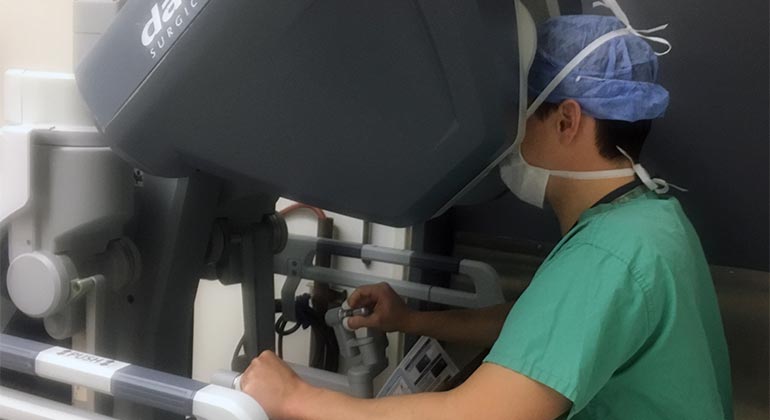Center for Minimally Invasive and Robotic Surgery

Mount Sinai has been a leading institution in the management of head and neck disease for nearly half a century, treating disorders ranging from thyroid cancer to skull-base tumors. Today many of these procedures can be performed using minimally invasive and robotic surgery techniques, which minimizes scarring and time spent in the hospital. Our multidisciplinary Head and Neck Surgical Center provides each patient with a team of nationally recognized surgeons and physicians who work together to treat head and neck tumors, additionally incorporating complex reconstructive procedures if appearance is an issue.
Robotic Surgery for Head and Neck Disease and Sleep Apnea
Mount Sinai surgeons use robotic surgery for some patients to treat head and neck tumors and sleep apnea without creating external incisions. In this way, we can avoid scarring, minimize complications, and reduce length of stay.
In TransOral Robotic Surgery (TORS), a surgeon sits at a console directly controlling a robotic arm. This arm extends a small surgical instrument through the patient's mouth. Using a high powered 3-D camera, surgeons can see the surgical field better, giving them greater dexterity and surgical precision. Robotic surgery has been highly beneficial in decreasing length of stay and improving postoperative swallowing capabilities and speech.
TORS is highly effective for the removal of head and neck tumors, as well as for the treatment of sleep apnea. Mount Sinai is one of only a few hospitals worldwide offering this robotic procedure to remove excess tissue or repair a collapsed airway, both causes of sleep apnea.
During this procedure, a laser removes the extra tissue in the throat that contributes to the airway obstruction. Patients typically return home the next day, and are back to work in 10 days, sleeping and breathing normally.
Endoscopic and Minimally Invasive Surgery for Head and Neck Tumors
Some head and neck tumors can be treated without surgery, but when surgery is required, Mount Sinai’s Head and Neck Surgical Center is highly skilled at using advanced, minimally invasive techniques to remove tumors of the larynx, pharynx, thyroid, parathyroid and skull base, while preserving voice and swallowing capabilities.
Using an endoscope — a thin, lighted instrument — inserted into your nose, your doctor peers into your body through the eye piece. Much like a telescope with a wide angle lens, the endoscope beams light into different parts of your nose and sinus cavity, allowing your doctor to search for tumors. Surgical instruments are then used along with the endoscope to remove the tumors without cutting through the skin. Your doctor can also use robotic surgery to gain access to difficult areas
Skull-base tumors can also be removed through minimally invasive and endoscopic techniques. Our skull-base surgeons are experts in resecting (removing) head and neck tumors without creating facial incisions.
Mount Sinai also use minimally invasive techniques to remove thyroid and parathyroid tumors through incisions often less than one-inch long. We can perform these procedures using local anesthesia, enabling our patients to go home that very day.
